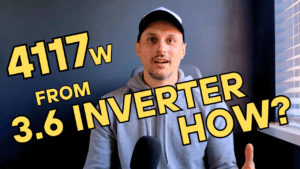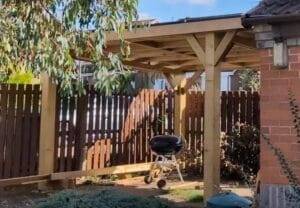Hybrid inverters have AC-Coupled input ports for taking additional power from microsieverts or generators. Use this to easily add more PV capacity.

I built a DIY solar energy system for my home in the late spring of 2023. It was a pleasant experience to see it harvest more and more energy each day. But, as the days grew shorter in autumn and winter, the energy production dropped sharply. I realised I needed more panels.
I am sure others have been in this situation too. Luckily there is a simple solution to this problem, add more panels. Easier said than done, though. In this article I will offer a potential solution with microinverters or string inverters alongside a hybrid inverter, read on.
In This Article:
Why Adding More Panels Can Be Challenging?
The usual challenges are related to several reasons.
- Space for panels – your roof can only fit so many panels safely
- You have maxed your inverter’s capacity to take more PV.
- You don’t have spare MPPTs on the inverter – you have space for panels, but they’ll be facing a different direction, and you want them on a separate string.
These constraints can be particularly frustrating when you wish to add a minor upgrade such a one or two panels. For example, there is a sunny patch on a wall that can help you harvest some much needed energy during the winter. Another example is a shed or a garage roof.
Panel Connection Strategies May Be Some Help
Variations in panel wiring may be some help in limited scenarios. Strategies such as connecting panels in parallel or parallel strings could work well when working around inverter voltage capacities. However, these strategies will not help with the other two constraints we listed above.
Expand With Microinverters

Microinverters can help with all of the constraints listed above. They take DC input from a single panel and convert directly to AC. Instead of delivering the AC to your home, you can plug it into your hybrid inverter. Please note, only some hybrid inverters support AC-coupled external sources such as microinverters or string inverters.
Microinverters Alongside a Hybrid Inverter
When your existing strings occupy all of the available MPPTs on your inverter, you can expand with microinverters. Bringing the AC output from microinverters directly to the hybrid inverter offers a key benefit: you can charge your battery from the microinverter. It is important to distinguish between configuring your hybrid inverter to charge from the generator or auxiliary AC input (where your microinverters are connected) versus charging from the grid. Such a configuration can help ensure your battery is only charged from the energy your panels produce.
Here’s a video where I explain how I applied the same principle but went for a string inverter
Configure Your Sunsynk Hybrid Inverter to Work With Microinverters
Sunsynk hybrid inverters offer superior settings and customisation for adding AC input.
There is a dedicated menu screen for microinverters. This section also works for string inverters as well. You can access it from the Aux Load section.

There is a great benefit to bringing AC from an auxiliary inverter to the Sunsynk hybrid inverter. This way, you can use the AC from the auxiliary inverter to charge the batteries and supply your home.
I ran across a gotcha when configuring a Sunsynk inverter with AC input. To charge the battery with the full potential of the AC input, you need to make sure that the Grid Charge setting in the battery charge menu is set high enough. You need to divide the power of your microinverter by the voltage it produces, i.e. 800W/230V=3.5A. So, you need to set the Grid Charge to 4A to ensure this will work well.
Examples of Hybrid Inverters That Support AC Input From Microinverters
Sunsynk stands out in this category. Their inverters support AC input from microinverters or string inverters, generators, wind turbines and the user manual clearly describes how to configure your inverter for each. You can read my review on the Sunsynk 3.6 ECCO inverter I own and find more details in the user manual.
I looked for more examples of hybrid inverters and their support for AC input from microinverters or string inverters. A Quick check on City Plumbing’s website, an established retailer of solar energy components in the UK, shows the following options for hybrid inverters.
| Brand and model | Supports Generator Input | Mentions Microinverters in the Manual |
|---|---|---|
| Sunsynk | Yes | Yes |
| Alpha SMILE | Yes | No |
| Goodwe GW6000 | Signal Only | No |
| Solax | No | No |
| Solis | Yes | No |
Regulations
With the introduction of microinverters, you are essentially adding more generation capacity to your system. If the end result is you exceed 3.68kW per phase, you need to apply for a G99 notification with your Distribution Network Operator (DNO). This requirement is to comply with the Engineering Recommendation G99 for generation installations .
My Experience With Adding An Inverter
I have a Sunsynk 3.6 ECCO. I am expanded my solar capacity adding a Growatt 2kW string inverter. Using the method described in the article so far, I am connecting the Growatt to the AC input port of the Sunsynk. Consequently, I am applying for a G99 DNO notification, and so far, I have received the go-ahead to connect.
In Hindsight
Instead of a 3.6kW inverter, I should have chosen the larger 5.5kW Sunsynk inverter and applied for G99. I installed my system DIY. The two-step process of G99 DNO notification looked like a riskier option. With my non-existent experience at the time, I decided staying within G98 regulations seemed easier. Keeping it easy led me to select the smaller inverter.
I am applying for G99 now anyway, but with a more complicated design than it would have been when I first built the system.
My Reason For Expansion
Why do I need more panels, you might ask? For the winter days. My panels are split into two strings facing East and West. My west-facing string is covered in uniform shadow from a nearby building for five months of the year. I need more solar, so I am building an east-facing gazebo and mounting panels on its roof.
Conclusion
Using microinverters to add a few panels to a constrained string is a viable strategy. It is even easier if your hybrid inverter supports AC input from microinverters, too. You need to watch out for exceeding the 3.68kWh generation capacity per phase. However, you can solve this problem by applying for a G99 DNO and carry on with the expansion.



